Dr. John Thøgersen
Professor Department of Management - MAPP - Research on Value Creation in the Food Sector, Department of Management, Aarhus University, Denmark
Dr. Ravi ARON
Associate Professor of Information Technology in the Carey Business School at John Hopkins University, USA.
Dr. Suvit MAESINCEE,
Minister of Higher Education, Science, Research and Innovation, the Government of Thailand
Dr. Joyce SERIDO
Associate Professor and Extension Specialist in the Department of Family Social Science at University of Minnesota, Twin Cities, USA.
Half-Day Local Tour
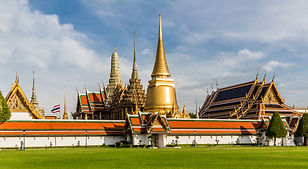

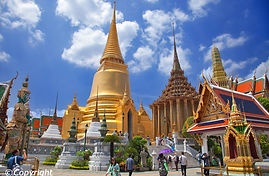
Wat Phra Kaew (Thai: วัดพระแก้ว), commonly known in English as the Temple of the Emerald Buddha and officially as Wat Phra Si Rattana Satsadaram,[a] is regarded as the most sacred Buddhist temple (wat) in Thailand. The Emerald Buddha housed in the temple is a potent religio-political symbol and the palladium (protective image) of Thailand.The temple is in Phra Nakhon District, the historic centre of Bangkok, within the precincts of the Grand Palace.
The main building is the central phra ubosot that houses the statue of the Emerald Buddha. According to legend, this Buddha image originated in India where the sage Nagasena prophesied that the Emerald Buddha would bring "prosperity and pre-eminence to each country in which it resides". The Emerald Buddha deified in the Wat Phra Kaew is therefore deeply revered and venerated in Thailand as the protector of the country. Historical records date its finding to the 15th century in Chiang Rai where, after it was relocated a number of times, it was finally brought to Thailand in the 18th century. It was enshrined in Bangkok at the Wat Phra Kaew Temple in 1782 during the reign of Phutthayotfa Chulalok, King Rama I (1782–1809). This marked the beginning of the Chakri dynasty of Thailand, whose current sovereign is Vajiralongkorn, King Rama X.
The Emerald Buddha, a dark green statue, is in a standing form, about 66 centimeters (26 in) tall, carved from a single jade stone ("emerald" in Thai means deep green colour and not the specific stone). It is carved in the meditating posture in the style of the Lanna school of northern Thailand. Except for the Thai King and, in his stead, the crown prince, no other persons are allowed to touch the statue. The king changes the cloak around the statue three times a year, corresponding to the summer, winter, and rainy seasons, an important ritual performed to bring good fortune to the country during each season
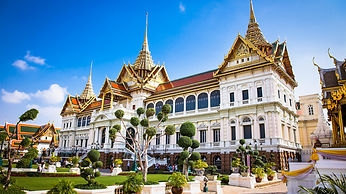
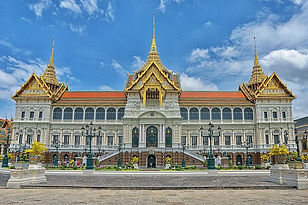
The Grand Palace (Thai: พระบรมมหาราชวัง, RTGS: Phra Borom Maha Ratcha Wang[1]) is a complex of buildings at the heart of Bangkok, Thailand. The palace has been the official residence of the Kings of Siam (and later Thailand) since 1782. The king, his court, and his royal government were based on the grounds of the palace until 1925. King Bhumibol Adulyadej (Rama IX), resided at the Chitralada Royal Villa and his successor King Vajiralongkorn (Rama X) at the Amphorn Sathan Residential Hall, both in the Dusit Palace, but the Grand Palace is still used for official events. Several royal ceremonies and state functions are held within the walls of the palace every year. The palace is one of the most popular tourist attractions in Thailand.
Construction of the palace began on 6 May 1782, at the order of King Phutthayotfa Chulalok (Rama I), the founder of the Chakri Dynasty, when he moved the capital city from Thonburi to Bangkok. Throughout successive reigns, many new buildings and structures were added, especially during the reign of King Chulalongkorn (Rama V). By 1925, the king, the Royal Family and the government were no longer permanently settled at the palace, and had moved to other residences. After the abolition of absolute monarchy in 1932, all government agencies completely moved out of the palace.
In shape, the palace complex is roughly rectangular and has a combined area of 218,400 square metres (2,351,000 sq ft), surrounded by four walls. It is situated on the banks of the Chao Phraya River at the heart of the Rattanakosin Island, today in the Phra Nakhon District. The Grand Palace is bordered by Sanam Luang and Na Phra Lan Road to the north, Maharaj Road to the west, Sanam Chai Road to the east and Thai Wang Road to the south.
Rather than being a single structure, the Grand Palace is made up of numerous buildings, halls, pavilions set around open lawns, gardens and courtyards. Its asymmetry and eclectic styles are due to its organic development, with additions and rebuilding being made by successive reigning kings over 200 years of history. It is divided into several quarters: the Temple of the Emerald Buddha; the Outer Court, with many public buildings; the Middle Court, including the Phra Maha Monthien Buildings, the Phra Maha Prasat Buildings and the Chakri Maha Prasat Buildings; the Inner Court and the Siwalai Gardens quarter. The Grand Palace is currently partially open to the public as a museum, but it remains a working palace, with several royal offices still situated inside.
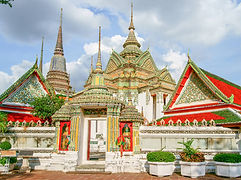
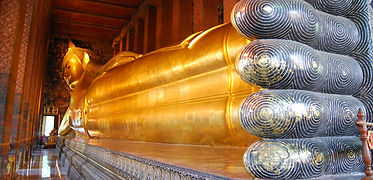
Wat Pho (Thai: วัดโพธิ) also spelled Wat Po, is a Buddhist temple complex in the Phra Nakhon District, Bangkok, Thailand. It is on Rattanakosin Island, directly south of the Grand Palace. Known also as the Temple of the Reclining Buddha, its official name is Wat Phra Chetuphon Wimon Mangkhalaram Rajwaramahawihan .The temple is first on the list of six temples in Thailand classed as the highest grade of the first-class royal temples.] It is associated with King Rama I who rebuilt the temple complex on an earlier temple site. It became his main temple and is where some of his ashes are enshrined. The temple was later expanded and extensively renovated by Rama III. The temple complex houses the largest collection of Buddha images in Thailand, including a 46 m long reclining Buddha. The temple is considered the earliest centre for public education in Thailand, and the marble illustrations and inscriptions placed in the temple for public instructions has been recognised by UNESCO in its Memory of the World Programme. It houses a school of Thai medicine, and is also known as the birthplace of traditional Thai massage which is still taught and practiced at the temple.
Tentative Schedule Sunday, July 12, 2020
09:00 Departure from Sasin School of Management
09:30 Arrived Wat Pho
11:00 Walked to Wat Phra Kaew – The Grand Palace
12:00 Lunch
14:00 Back to Sasin School of Management
This is an optional program for participants. There will be an additional THB 2,000 per person fee. Price includes transportation, entrance fee, and lunch meal. Advanced reservation before May 30, 2020 is mandatory.